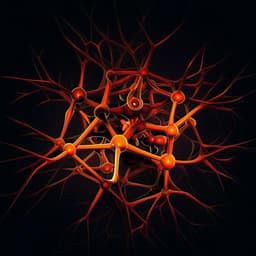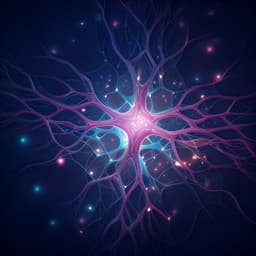
Medicine and Health
Optically-generated focused ultrasound for noninvasive brain stimulation with ultrahigh precision
Y. Li, Y. Jiang, et al.
Discover how Yueming Li, Ying Jiang, Lu Lan, Xiaowei Ge, Ran Cheng, Yuewei Zhan, Guo Chen, Linli Shi, Runyu Wang, Nan Zheng, Chen Yang, and Ji-Xin Cheng have revolutionized brain stimulation with their groundbreaking optically-generated focused ultrasound (OFUS) technology, achieving unmatched precision in neuromodulation. This innovative method could significantly enhance our understanding of brain function and treatment for neurological diseases.
~3 min • Beginner • English
Introduction
To understand how the brain functions and how its dysfunction causes diseases, modalities to modulate neuronal activity with ultrahigh precision are needed. Brain stimulation modalities with millimeter precision usually activate multiple functional regions and cause unintended responses. For example, limited spatial precision prevents the activation of individual brain regions, making it difficult to map the motor cortex in mice. A spatial precision better than 0.2 mm is desired for precise targeting in stimulating specific cell layers in the rat hippocampus. For decoding the human brain from an engineering point of view, an ultrahigh spatial resolution of stimulation to match the resolution for reading (0.1 mm) is desirable for single neuron-based systems in brain-computer interfaces. Therefore, a neuromodulation tool with ultrahigh precision is needed for mapping the brain sub-regions by modulating a small population of neurons. Electrical stimulation tools are a gold standard for neuromodulation studies and disease treatments. Deep brain stimulation with implanted electrodes has been approved for the clinical treatment of Parkinson’s disease, depression, and epilepsy. However, the current leakage over several millimeters limits the precise control of targeting in electrical stimulation. Optogenetics provides an unrivaled sub-cellular spatial resolution and specificity for targeted cell types, which has advanced the study of neuroscience. Recently developed transcranial optogenetics in mice can target a brain area of 0.8 to 1 mm laterally at a penetration depth of 5–6 mm without surgery. However, transcranial optogenetics only provides a high transmission rate of ~0.02% at 7 mm. Therefore, there is an increased risk of heat accumulation along the light path in the illuminated tissue at powers that deliver sufficient light energy. Furthermore, both conventional and transcranial optogenetics rely on viral transfection, which has limited their applications in the human brain. Non-invasive non-genetic neuromodulation is attractive as it avoids the risk of surgery and is applicable to the human brain. Transcranial direct current stimulation (tDCS) and transcranial magnetic stimulation (TMS) provide a spatial resolution at the centimeter level due to the long wavelength of the electromagnetic waves used. The emerging transcranial-focused ultrasound (FUS) as a non-invasive neuromodulation technique offers millimeter-level precision in various models, such as mice, monkeys, and even humans. An ultrasound frequency of ~1 MHz or less is preferred in FUS for high transcranial efficiency, but limits its spatial resolution at 1 to 5 millimeters. Ultrasound with higher frequencies also draws attention for its high spatial resolution. 5 MHz ultrasound has been demonstrated to induce electrophysiological (EMG) responses in mouse brains with a submillimeter spatial resolution of 0.3 mm. Stimulation in the frequency range demonstrated ex vivo with a transducer's center frequency of 43 MHz. Very recently, it was shown that high-frequency ultrasound was delivered through a cranial window. Thus far, non-invasive neuromodulation with focused ultrasound with a spatial resolution of 0.1 mm has not been demonstrated. Non-invasive non-genetic neuromodulation with ultrahigh precision remains a critical unmet need. The optoacoustic effect is an alternative way to generate ultrasound. Optoacoustic materials absorb a short pulse of light and convert it into a transient temperature increase and thermal expansion and compression, resulting in the generation of an ultrasound pulse. To maximize the light-to-sound conversion efficiency, photocoagulate materials composed of light-absorbing units and thermal expansion units are extensively explored. Polydimethylsiloxane (PDMS) has drawn much attention as a thermal expansion material because of its high thermal expansion and transparency. For light absorbers, materials of interest include metal and carbon materials, including gold, titanium, chrome, carbon black, carbon nanotube, carbon nanofiber, carbon nanoparticles, and candle soot. While metal-based materials have a high light absorption at certain wavelengths due to the resonance effect, carbon-based materials provide a broadband absorption and compatibility with a variety of laser systems. Recently Liang et al. and Shi et al. reported fiber-based optoacoustic emitters coated with a mixture of carbon-based materials and epoxy/PDMS for submillimeter and single neuron stimulation. The design of tapered fiber optoacoustic emitters with a diameter of 20 μm, enables selective activation of subcellular structures as a point source of ultrasound. However, since they exploit near-field ultrasound for localized neuromodulation, fiber optoacoustic emitters need to be surgically implanted to the target and cannot be applied transcranially. Here, we report the development of optically-generated focused ultrasound (OFUS) for non-invasive neuromodulation with ultrahigh precision below 0.1 mm for the first time. OFUS is generated by a curved soft optoacoustic pad (SOAP) upon a nanosecond laser excitation. SOAP is fabricated using PDMS and a carbon-based absorber. The transverse diameter was tailored to provide a numerical aperture (NA) of 0.95 to enable a tighter spatial focusing and to maximize the focal pressure. This NA is close to the theoretical limit of 1 and much larger than that of a typical conventional lead zirconate titanate (PZT)-based transducer. To identify the optimal absorber for efficient conversion of photons to acoustic waves, SOAPs based on four different optoacoustic materials were fabricated and tested, including heat shrink membrane (HSM), carbon nanomixes mixed with PDMS (CNT-PDMS), carbon nanoparticles mixed with PDMS (C-PDMS), and carbon black mixed with PDMS (CS-PDMS). The PDMS SOAP was found to be the most efficient, generating ~48 MPa at the ultrasound focus under a 0.62 mJ/ cm2 laser input. We further demonstrated that CS-PDMS OFUS produces an ultrahigh spatial resolution of ~38 μm with transcranial capability, which is two orders of magnitude improvement from the resolution of a few millimeters offered by FUS. We achieved direct and transcranial single-cycle OFUS stimulation reliably and safely, verified by calcium imaging in fluorescent neurons in vivo. The total ultrasound energy input of OFUS is found to be four orders of magnitude less than that of tFUS when evoking a similar level of neural response. Lastly, we validated the functional outcomes of OFUS stimulation in the mouse motor cortex by electrophysiological recording in vivo.
Literature Review
The paper reviews limitations of existing neuromodulation modalities: electrical deep brain stimulation achieves clinical efficacy but suffers from current spread over millimeters, reducing targeting precision. Optogenetics provides subcellular specificity and high lateral resolution (0.8–1 mm at 5–6 mm depth transcranially in mice) but requires genetic transfection and has very low transcranial transmission (~0.02% at 7 mm) with potential heating risks. Non-genetic, non-invasive methods like tDCS and TMS have centimeter-scale spatial resolution due to long EM wavelengths. Conventional transcranial focused ultrasound (tFUS) typically uses ≤1 MHz for skull transmission, limiting spatial resolution to 1–5 mm. Higher-frequency ultrasound promises better resolution; 5 MHz has induced EMG responses with ~0.3 mm resolution in mice, and 43 MHz stimulation has been shown ex vivo or through cranial windows, but truly non-invasive 0.1 mm resolution had not been demonstrated. Prior optoacoustic emitters based on carbon materials and PDMS/epoxy on tapered optical fibers achieved subcellular stimulation but require invasive implantation and operate in the near field, precluding transcranial application. This context motivates a non-invasive, non-genetic approach with ultrahigh precision.
Methodology
Design and simulation: The authors designed a soft optoacoustic pad (SOAP) comprising a PDMS substrate with a curved optoacoustic layer that, upon nanosecond laser excitation, emits ultrasound from the curved surface to form a focus. Two-dimensional k-Wave simulations in MATLAB modeled the curved layer as a thin acoustic source with air backing and water coupling, using a central frequency of 15 MHz and fixing a 2 mm working distance from the SOAP top surface to the acoustic focus. By varying the radius and transverse diameter, they evaluated lateral and axial focal resolutions (FWHM) as functions of numerical aperture (NA, defined by transverse diameter/radius). The simulated lateral resolution R showed an inverse dependence on NA, consistent with acoustic-resolution photoacoustic microscopy, following Rl = 0.71 ν/(NA·f). A higher NA improved both lateral and axial resolutions; designs targeted NA ≈ 0.95 to approach the focusing limit and maximize focal pressure. Fabrication of SOAP variants: Four absorber configurations were fabricated with identical geometry/NA: (1) heat shrink membrane (HSM) serving as both absorber and expansion medium; (2) carbon nanotube-PDMS (CNT-PDMS); (3) carbon nanoparticle-PDMS (CNP-PDMS); and (4) candle soot-PDMS (CS-PDMS). For the carbon-based designs, carbon materials were embedded within PDMS, which provides thermal expansion. CS-PDMS fabrication involved depositing candle soot onto a curved surface then transferring and encapsulating with PDMS (details referenced in Methods/Supplementary Fig. S2). Structural and compositional characterization: Cross-sections of CS-PDMS SOAP were microtomed (~200 μm thick) and imaged by SEM, revealing a mixed CS-PDMS layer (~2.7 μm thick) atop pure PDMS, close to the theoretical optimal transduction thickness (~2.15 μm). CS particle diameter (~55 nm) and deposition rate (~200 μm/s) were consistent with prior reports. Label-free stimulated Raman scattering (SRS) and photothermal imaging mapped PDMS (CH bonds) and candle soot distributions, corroborating a ~3 μm mixed layer and a clear boundary with pure PDMS. Acoustic characterization: Nanosecond laser pulses at 0.62 mJ/cm² irradiated each SOAP while a needle hydrophone measured the focused pressure waveforms and spectra. HSM produced the smallest signal; CNT-PDMS and CNP-PDMS yielded comparable amplitudes. CS-PDMS generated the largest focused pressure (~48 MPa) under identical optical input, approximately 6× higher than CNT/CNP-PDMS and 5× above HSM. Measured ultrasound pulse widths for HSM, CNT-, CNP-, and CS-PDMS were reported (values partially truncated in the provided text). System parameters and targeting: The OFUS system operated at a central frequency of 15 MHz with an NA of ~0.95 and a designed 2 mm working distance, achieving tight focusing. The device produced a transcranial focus with an ultrahigh lateral resolution reported as 83 μm and, for CS-PDMS, ~38 μm with transcranial capability. Neuromodulation assays: The authors tested OFUS neuromodulation in vitro using single-cycle ultrasound pulses and validated activation by calcium imaging. In vivo, they performed submillimeter transcranial stimulation of the mouse motor cortex and recorded electrophysiological responses, using acoustic energy inputs as low as 0.6 mJ/cm², substantially below those typical for tFUS.
Key Findings
- OFUS generated by a curved CS-PDMS SOAP at 15 MHz can achieve an ultrahigh lateral focal resolution of 83 μm transcranially, two orders of magnitude finer than conventional tFUS (millimeter scale).
- CS-PDMS OFUS demonstrated an ultrahigh spatial resolution of approximately 38 μm with transcranial capability (as reported), representing a substantial improvement over existing non-invasive approaches.
- The CS-PDMS design provided superior optoacoustic conversion, producing ~48 MPa focused pressure under 0.62 mJ/cm² laser excitation, about 6-fold higher than CNT- and CNP-PDMS and markedly higher than HSM.
- Effective neuromodulation was achieved with a single ultrasound cycle in vitro, and submillimeter transcranial stimulation of mouse motor cortex was demonstrated in vivo.
- Successful neuromodulation required only ~0.6 mJ/cm² acoustic energy, roughly four orders of magnitude less than energy typically used in tFUS to elicit similar neural responses.
- High-NA (≈0.95) focusing and a 15 MHz center frequency enabled tight focusing while maintaining transcranial capability.
- Structural analysis confirmed an optimized ~2.7–3 μm CS-PDMS mixed layer close to theoretical optimal thickness, supporting efficient light-to-sound conversion.
Discussion
The study addresses the critical need for non-invasive neuromodulation with sub-0.1 mm spatial precision. By leveraging optoacoustic generation from a high-NA curved CS-PDMS pad, OFUS achieves ultrahigh lateral resolution (down to 83 μm transcranially and ~38 μm as reported), surpassing the millimeter-scale focusing limits of conventional low-frequency tFUS and the centimeter-scale fields of tDCS/TMS. Compared to optogenetics, OFUS avoids genetic modification and mitigates issues of low transcranial light transmission and thermal loading along the optical path, since acoustic focusing occurs at depth while using modest optical fluence at the source. The substantial pressure generation (~48 MPa at the focus for 0.62 mJ/cm² input) demonstrates efficient light-to-sound conversion in the CS-PDMS composite, validated by structural and chemical characterization of the optoacoustic layer. The ability to evoke neural activity with single-cycle pulses and at energy levels four orders of magnitude below tFUS suggests reduced risk of off-target effects and heating, enabling precise mapping of brain subregions and potentially targeting specific cortical layers. In vivo demonstrations in mouse motor cortex and electrophysiological verification underscore the translational potential of OFUS as a precise, non-invasive, non-genetic neuromodulation modality.
Conclusion
The authors introduce optically-generated focused ultrasound (OFUS) using a curved CS-PDMS soft optoacoustic pad to achieve non-invasive neuromodulation with ultrahigh spatial precision. Through design optimization (NA ≈ 0.95), simulations, and materials screening, they realize a transcranial focal spot at 15 MHz with lateral resolution on the order of tens of micrometers and efficient pressure generation (~48 MPa at 0.62 mJ/cm²). OFUS reliably induces neuromodulation with single-cycle pulses in vitro and elicits submillimeter motor cortex responses in vivo at energy inputs four orders of magnitude below tFUS. These advances open avenues for precise mapping of neural circuits and targeted stimulation for research and therapeutic applications. Future work could focus on comprehensive safety characterization (thermal and mechanical indices), optimization of transcranial efficiency across skull types and thicknesses, scaling to larger brains, integration with imaging and closed-loop systems, and exploration of frequency/NA trade-offs for deeper targets while maintaining high precision.
Limitations
Related Publications
Explore these studies to deepen your understanding of the subject.







